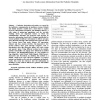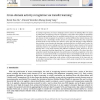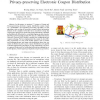PERCOM
2011
ACM
13 years 6 months ago
2011
ACM
—The emergence of personal mobile device with low cost sensors, such as accelerometer and digital compass, has made dead-reckoning (DR) an attractive choice for indoor pedestrian...
PERCOM
2011
ACM
13 years 6 months ago
2011
ACM
Abstract—The adaptive ubiquitous services, which dynamically adapt behaviors to requirements and contexts, are one of the major challenges in the ubiquitous computing. To facilit...
PERCOM
2011
ACM
13 years 7 months ago
2011
ACM
PERCOM
2011
ACM
13 years 7 months ago
2011
ACM
—In this paper, we consider the problem of tracking fine-grained speeds variations of vehicles using signal strength traces from GSM enabled phones. Existing speed estimation te...
PERCOM
2011
ACM
13 years 7 months ago
2011
ACM
—We present a technique to discover the position of sensors on the human body. Automatic on-body device localization ensures correctness and accuracy of measurements in health an...
PERCOM
2011
ACM
13 years 7 months ago
2011
ACM
Abstract—Pervasive vehicle-mounted mobile devices are increasingly common, and can be viewed as a large-scale ad hoc network on which collaborative, location-based services can b...
PERCOM
2011
ACM
13 years 7 months ago
2011
ACM
— This paper focuses on the problem of rostering in intermittently connected passive RFID networks. It aims to report a list of tagged mobile nodes that appear in given intereste...
PERCOM
2011
ACM
13 years 7 months ago
2011
ACM
—In this paper, we propose P3 -coupon, a Prompt and Privacy-preserving electronic coupon distribution system based on a Probabilistic one-ownership forwarding algorithm. In this ...
PERCOM
2011
ACM
13 years 7 months ago
2011
ACM
Abstract—With the abundance and ubiquity of mobile devices, a new class of applications is emerging, called participatory sensing (PS), where people can contribute data (e.g., im...



